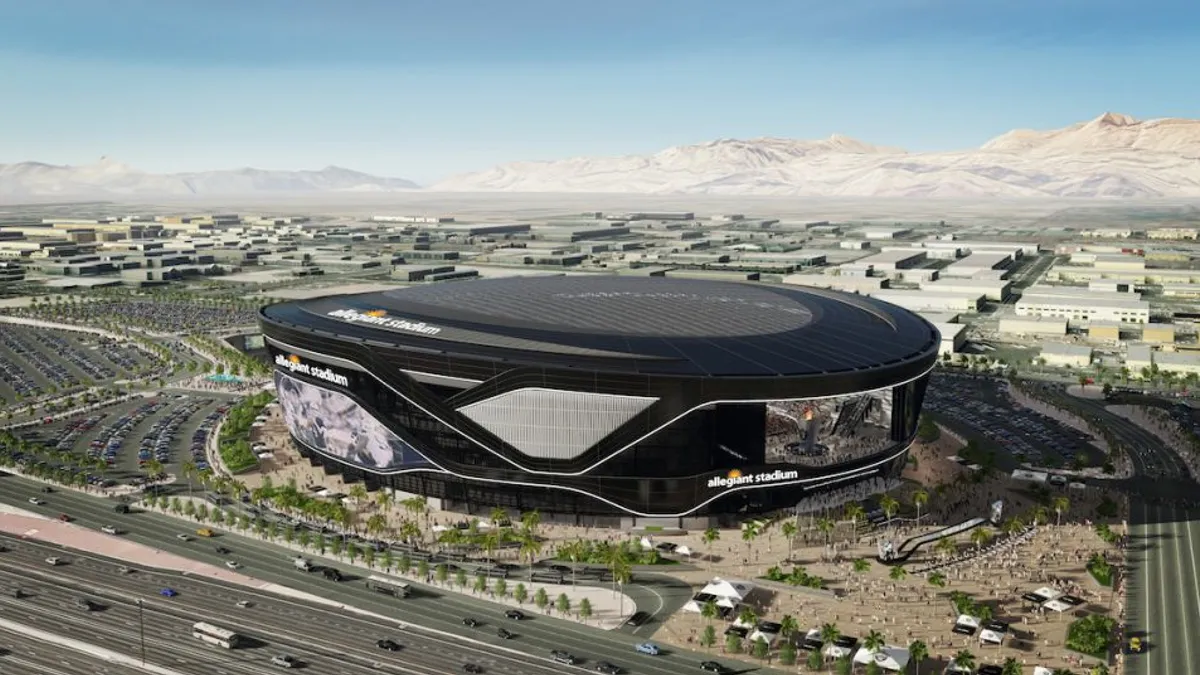Despite recent news reports that the completion date of Las Vegas’ new NFL stadium is in jeopardy due to issues with its roof installation, one of the project’s top construction managers said it is still on track for its scheduled July 31 completion date.
Installation of the cable net roof system for the $1.9 billion football stadium being built for the Raiders’ Allegiant Stadium was delayed, but not by several months as has been reported by some news outlets, Mortenson Vice President of Operations for Sports and Entertainment Eric Grenz told Construction Dive. The roof of the 65,000-seat venue, which was originally scheduled to be completed in mid-March, will now be finished in May.
The multi-pronged problem started Oct. 30 when when one of more than the 100 bolted connections on the circumferential compression ring formed by the steel canopy roof failed.
The project team immediately stopped work to consult with engineering experts including the structural engineer of record, Arup; Geiger Engineers; and Thornton Tomasetti, the erection engineer for the roof system, to help determine the cause and to prevent it going forward.
"We took an abundance of caution to make sure the health and well-being of workers and the structural integrity of the building wasn’t compromised,” Grenz said. "We had extra time in the schedule and we used it."
Over the course of the 10.5-week period leading up to the resumption of the “big lift” operations, the project team worked with engineers and building inspectors to modify the installation approach of the cable net truss system. Work on it resumed Jan. 12 and all work is proceeding according to plan, he said.
“Because of the oval shape of the roof, there is a demand capacity ratio that cannot be exceeded during the jacking operations of the cable net roof system,” Grenz said. “We had to go back and add more steps to some of those processes to ensure we had a uniform lift on the structure itself and make sure we're not overstressing parts of it.”
Allegiant's roof encompasses complex engineering dynamics that include a web of more than 100 stainless-steel cables that create a structural diaphragm and support the steel structure for the plastic ETFE roofing system, the same material used for the roof of the U.S. Bank Stadium in Minneapolis, another Mortenson project.
Mortenson is overseeing the design-build stadium project as part of a joint venture with McCarthy Building Cos. When complete, the venue will sport a sleek black glass exterior, retractable natural turf field and four rolling doors framing a 90-foot-tall, 200-foot-wide view of the Las Vegas Strip.
Grenz noted that the roof delay did not set back construction of any other parts of the 1.75 million-square-foot venue.
No weather issues
Grenz also refuted reports that rain could cause damage to interior finishes during the extra months that the structure will not be enclosed.
A November report prepared by an independent monitor for the Las Vegas Stadium Authority asserted that the delay in the overall building enclosure raises "the possibility of weather damage as more finish work is put in place. Our assessment is that the Temporary Certificate of Occupancy date may be in jeopardy if weather (rain) causes damage to interior finishes.”
This idea is “absolutely not true,” Grenz said, adding in fact, the same report states “no fewer than eight times” that the job is on budget and on schedule.
The Mortenson official said that a slight risk of water damage to the stadium interior was a possibility from the start of construction but is practically non-existent in Las Vegas during April and May. He noted that the site weathered higher than average rainfall in December — 1 inch compared to the average less than ½ inch — with no significant issues.
Moreover, the majority of the stadium’s interior finishes reside underneath the hard deck roof, Grenz said. The cable net and ETFE roof “doesn’t really protect anything other than the main field, so the fears of not having the ETFE in place doesn’t really correlate to damage of the interior finishes.”
The hard decked PVC roof portion of the canopy is protected by a tarp-like material in order to prevent water intrusion on the finished materials inside the building, he added.
Despite the concerns raised in the independent report, it states that the project will most likely meet its expected timeline.
“Although work activities (primarily for finish work) are beginning to stack up, it is still possible to achieve substantial completion on the date originally contemplated, understanding that punch list and other non-essential work may not be completed at the time of issuance of Temporary Certificate of Occupancy,” the independent monitor for the Las Vegas Stadium Authority reported. “Non-essential work could be items such as back-of-house storage facilities, auxiliary locker rooms not necessary for early stadium activities, management office spaces, final commissioning of MEP systems, punch list items and touch ups, etc.”
Grenz said he disagrees with this statement, noting that despite a minor delay in the progression of the cable net truss system, all other work activities have progressed forward as planned.
Grenz agrees that there is still an abundance of work to finish before the stadium opens in just over six months, but said the contractor has "the industry's most talented team members working on this project."
"I couldn’t be more pleased with our team's focus, resiliency and commitment to completing this project on time and on budget," he added. "Our team is capable of overcoming just about any obstacle or challenge that surfaces."





















